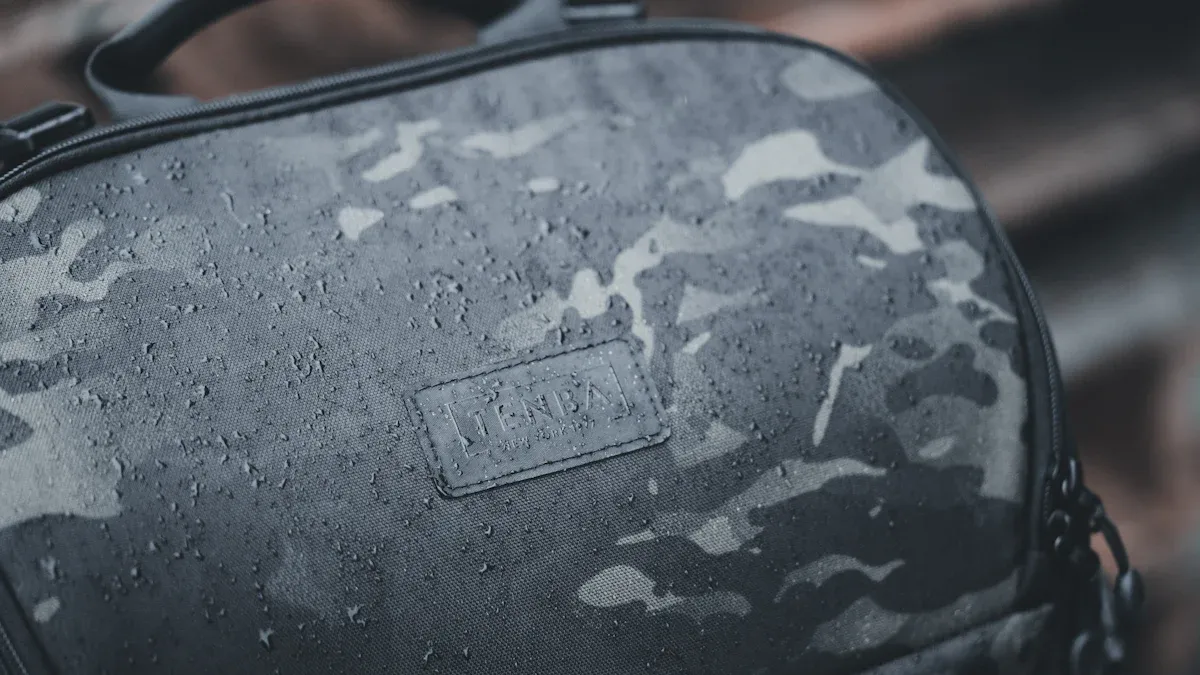How to Test the Waterproof Level of Your Backpack

Ever wondered if your backpack can really keep your stuff dry? You do not need fancy tools or a lab to find out. You can test the waterproof level of the backpack right at home or outside in your yard. Whether you hike, bike, or travel, knowing how much water your backpack can handle helps you stay prepared. Give these simple tests a try. You might feel surprised by what you discover!
Key Takeaways
- Know the difference between waterproof and water-resistant backpacks. Waterproof bags stop all water from getting in. Water-resistant bags only protect a little from water.
- Try easy tests at home to check your backpack. Use the paper towel test to see if water gets inside. You can also use a garden hose or test it in real rain. These tests help you find leaks.
- Look closely at seams and zippers. Water often gets in through these spots. Make sure they are sealed and work well.
- Pick the right backpack for your activities. If you will be in heavy rain, choose a bag with a high IPX rating. Make sure the seams are sealed too.
- Test your backpack often before trips. This helps you find leaks early. It keeps your things dry when you travel.
What Does Waterproof Mean?
When you look for a backpack, you see words like “waterproof” and “water-resistant.” These words seem alike, but they are not the same. You need to know what they mean before you test your backpack.
Waterproof vs. Water-Resistant
Waterproof backpacks keep water out, even in heavy rain or if you drop them in a puddle. In outdoor gear, waterproof means water cannot get inside, no matter what happens. Many waterproof backpacks use PU-coated nylon, PVC, or TPU. They have heat-sealed seams that stop water from getting in. You can trust these backpacks to keep your things dry when the weather is bad.
Water-resistant backpacks give some protection, but not full safety. These backpacks often use polyester or nylon with a coating. Their seams are not sealed, so water can get in during strong rain. Here is a quick comparison:
- Waterproof backpacks use special materials and sealed seams to block water.
- Water-resistant backpacks use coated fabrics and simple seams, so they only work in light rain.
- Waterproof bags can handle heavy rain and long wet times, but water-resistant bags may not work in tough weather.
Why It Matters
Picking waterproof or water-resistant backpacks is important. If you use a water-resistant backpack in heavy rain, water can get inside. Your things might get wet, and electronics or papers could be ruined. Water-resistant materials often fail in storms, so your stuff gets soaked. You need strong protection if you carry important items or travel in bad weather.
Tip: Always look at the seams and zippers before you buy. These places are weak spots where water can get in.
Knowing these differences helps you choose the right backpack for your trips. When you test your backpack, you will know what to expect in real life.
How to Test the Waterproof Level of the Backpack

You want to know if your backpack can really keep your gear dry. You do not need special tools or a lab. You can test the waterproof level of the backpack at home with a few simple items. Here are the best ways to check if your backpack is ready for rain, puddles, or even a surprise storm.
Paper Towel Test
The paper towel test is one of the easiest ways to test the waterproof level of the backpack. You only need a few things you probably already have at home.
What you need:
- 3 to 5 different types of paper towels
- Measuring cup or clear plastic cup
- Small bowl of water
- Marker
- Paper and pen for notes
Steps:
- Open your backpack and place dry paper towels inside. Make sure you cover the bottom and corners.
- Zip up or close the backpack as you would for a hike.
- Use a measuring cup or bowl to pour water over the outside of the backpack. You can also use a spray bottle for more control.
- Wait 5-10 minutes. This gives water time to find any weak spots.
- Open the backpack and check the paper towels. If they are dry, your backpack passed the test. If you see wet spots, water got in.
Tip: The paper towel test works well for finding small leaks in seams or zippers. It can show you problems that you might miss with other tests.
Garden Hose or Showerhead Test
If you want to test the waterproof level of the backpack with more water, try the garden hose or showerhead test. This method is great for simulating heavy rain.
How to do it:
- Place dry paper towels inside your backpack.
- Close all zippers and flaps tightly.
- Set your backpack upright outside or in the shower.
- Use a garden hose or showerhead to spray water all over the backpack for 5-10 minutes. Move the spray around to hit all sides.
- After spraying, let the backpack sit for a few minutes.
- Open the backpack and check the paper towels for any wet spots.
This test helps you see how your backpack handles a downpour. You can also spot leaks around seams and zippers.
Note: Do not use high-pressure settings. Too much force can damage the fabric or seams.
Fill with Water Test
This test is a bit more extreme, but it can help you find leaks fast. Only use this method if your backpack claims to be fully waterproof.
Steps:
- Turn your backpack inside out if possible.
- Fill the main compartment with water using a measuring cup.
- Watch for drips or leaks from seams, corners, or the bottom.
- If you see water escaping, mark the spot with a marker.
You can also gently squeeze the backpack to see if water pushes through. This pressure test can reveal tiny holes or weak seams.
Caution: Do not leave water in the backpack for too long. Empty and dry it right away to avoid damage.
Real-World Rain Test
Nothing beats testing your backpack in real rain. Take your backpack outside during a steady shower and see how it performs.
How to do it:
- Place dry paper towels or a dry shirt inside your backpack.
- Close all zippers and flaps.
- Walk or leave your backpack outside in the rain for 30 minutes to 1 hour.
- Bring it inside and check for any wet spots inside.
| Aspect | Lab Rain Test (MIL-STD-810/IEC 60529) | Real-World Rain Test |
|---|---|---|
| Test Setup | Rain chamber or nozzle system | Natural rain outdoors |
| Evaluation Criteria | Water ingress, functional operation | Wet spots inside the bag |
| Rating System | IP code or none | Pass/fail based on dryness |
The real-world rain test shows you how your backpack will perform when you need it most. You can spot leaks that might not show up in quick tests.
Check Seams and Zippers
When you test the waterproof level of the backpack, do not forget the seams and zippers. These are the most common places where water sneaks in.
What to look for:
- Zippers often let water in because of their fabric and design.
- Seams can have tiny holes from stitching.
- Check for peeling seam tape. If more than 10% is loose, re-tape it.
- Look for cracks or flaking in the waterproof coating.
- Make sure zippers move smoothly and do not let water collect inside.
- Use a flexible zipper sealant around zipper teeth for extra protection.
Note: Most waterproof failures happen at seams and zippers, not the main fabric. Always check these spots first.
Quick Checklist:
- Inspect all seams for loose tape or holes.
- Check zippers for smooth movement and gaps.
- Look for cracks in the coating.
- Test the waterproof level of the backpack after fixing any issues.
Precautions
- Do not use boiling or very hot water. It can damage the fabric.
- Avoid sharp objects when testing. They can poke holes in the bag.
- Dry your backpack completely after each test to prevent mold.
Testing the waterproof level of the backpack helps you find weak spots before your next adventure. You can fix small problems or decide if you need a new bag. Stay dry and ready for anything!
Waterproof Ratings

IP Ratings Explained
Some backpacks have an “IP” rating. “IP” means “Ingress Protection.” This rating shows how well your backpack blocks dust and water. The rating has two numbers. The first number is for dust and dirt. The second number is for water. Here is a simple guide:
| IP | First Character | Second Character |
|---|---|---|
| Stands for Ingress Protection | Protection against solids (dust, dirt, etc.) | Protection against liquids (water) |
| First Digit (Solids) | Description |
|---|---|
| IP0X | No protection from solids at all. |
| IP1X | Stops big objects over 50 mm. |
| IP2X | Stops objects over 12.5 mm. |
| IP3X | Stops objects over 2.5 mm. |
| IP4X | Stops objects over 1 mm. |
| IP5X | Some dust might get in, but not much. |
| IP6X | No dust can get inside at all. |
| Second Digit (Liquids) | Description |
|---|---|
| IPX0 | No protection from water. |
| IPX1 | Stops water dripping straight down. |
| IPX2 | Stops drips when tilted up to 15 degrees. |
| IPX3 | Stops water that sprays at it. |
| IPX4 | Stops splashes from any direction. |
| IPX5 | Stops low-pressure water jets. |
| IPX6 | Stops strong, high-pressure water jets. |
| IPX7 | Keeps water out if dropped in up to 1 meter for 30 minutes. |
| IPX8 | Keeps water out in deeper water than 1 meter. |
| IPX9K | Stops very strong, hot water and steam jets. |
If your backpack says IPX4, it can handle splashes from all sides. If it says IPX7, you can drop it in a puddle and your things should stay dry.
Common Materials
Backpacks use different materials to keep water out. Each one works in its own way. Here is a table to help you compare:
| Material | Waterproof Properties | Best Use Case |
|---|---|---|
| PVC (Polyvinyl Chloride) | Strong, fully waterproof, easy to clean, good for outdoor trips. | Great for camping or boating. |
| TPU (Thermoplastic Polyurethane) | Bends easily, light, fully waterproof, better for the planet than PVC. | Good for light waterproofing. |
| Nylon with Waterproof Coating | Not waterproof by itself, but coating makes it resist water. | Best for city or school backpacks. |
| Neoprene | Resists water, strong, handles rain and splashes, looks nice. | Good for stylish and useful bags. |
Check the tag or the product info to see what your backpack is made of.
Factors Affecting Waterproofness
Many things can change how waterproof your backpack is. Here are some important things to remember:
- DWR treatments help water slide off the bag.
- PU coatings make the fabric stronger and more waterproof.
- Tight weaves and lots of threads block water better.
- Thick fabric alone does not mean it is waterproof. The weave and coating matter more.
- Sun, wet places, and heavy loads can wear out waterproof coatings.
- Clean your backpack and use waterproof sprays to keep it ready for rain.
Tip: Always let your backpack dry all the way before you put it away. This stops mold and keeps the waterproof layer strong.
Interpreting Results
What the Results Mean
When you test the waterproof level of the backpack, you get real answers about how well it protects your gear. If your paper towels or clothes stay dry after each test, your backpack is ready for rain, puddles, or even a surprise storm. If you find damp spots, you know water can sneak in.
You can match your results to your needs by thinking about your activities. Here’s a simple way to decide if your backpack is up for the job:
- Day hikes or school: A backpack that keeps out light rain or splashes is usually enough.
- Camping or travel: You want a bag that stays dry in steady rain and has sealed seams.
- Kayaking or heavy storms: Only trust a backpack that passes every test and has a high IPX rating.
If your backpack fails, don’t worry. You can fix small leaks with a repair patch. Trim any loose threads, cut the patch to size, and press it on firmly. For extra strength, add seam sealer. If the seams are badly damaged or the repair costs more than a new bag, it might be time to replace it.
Tip: Always let repairs dry fully before you use your backpack again.
Choosing the Right Backpack
Picking the right backpack means looking at more than just waterproofing. You want a bag that fits your trip, feels comfortable, and keeps your things organized. Check out this table to help you compare:
| Criteria | Description |
|---|---|
| Type of Backpack | Choose based on your trip and how long you’ll be out. |
| Features | Look for straps, pockets, and covers for extra use and protection. |
| Durability | Pick strong materials and check waterproofing for tough trips. |
| Weather Protection | Make sure your bag has a rain cover or liner for extra safety. |
| Breathability | Mesh and vents help keep your back cool and dry. |
| Fit and Adjustability | Adjust straps and belts for comfort and good weight balance. |
You should also think about your own needs and the weather. If you expect heavy rain, pick a backpack with a high IPX rating and waterproof zippers. For everyday use, a water-resistant bag with good pockets might be enough.
If you want to stay dry, always test the waterproof level of the backpack before your next adventure. This way, you know your gear will stay safe and dry, no matter what the weather brings.
Testing your backpack’s waterproof level helps you feel ready before going outside. You find out what your backpack can really do. This way, you will not get caught off guard. Here is a simple table that shows real test results:
| Testing Scenario | Outcome |
|---|---|
| Simulated rainy trail conditions | Zippers made a big difference in keeping things dry |
| High-pressure hose test | Dry gear showed strong seals are important |
| Timed waterproof challenges | Good zippers were very important |
| Poorly sealed bag experience | Proved you should not just believe ads |
When you know what your backpack can handle, you can:
- Keep your electronics and clothes dry if it rains
- Stop your gear from getting wet on any trip
- Use waterproof features better by taking care of them
Remember, many people make mistakes. They trust labels too much, forget about membrane types, or do not check seams and zippers. Be ready for any weather by testing your backpack and knowing what it can really do!
FAQ
How often should you test your backpack’s waterproof level?
You should test your backpack before every big trip or after heavy use. If you notice wear, leaks, or damage, check it again. Regular testing helps you catch problems early.
Can you make a non-waterproof backpack more waterproof?
Yes! You can use waterproof sprays or add a rain cover. Seal seams with seam tape for extra protection. These steps help keep your gear dry in light rain.
What should you do if your backpack fails the waterproof test?
First, dry your backpack. Patch small holes with repair tape. Use seam sealer on weak seams. If the damage is too big, consider getting a new backpack for better protection.
Do all waterproof backpacks protect electronics?
Not always. Some backpacks keep out rain but may leak in heavy storms or if submerged. For electronics, use extra dry bags or pouches inside your backpack for extra safety.
See also
Comparing Summer Camping and Winter Camping
10 Essential Backpack Storage Skills for Camping Photographers
How to Secure a Fixed Backpack for Safe Cycling
Backpack Straps: How to Adjust the Straps for Optimal Comfort



Comments are closed